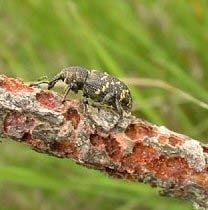PESTS AND DISEASES OF FORESTRY IN NEW ZEALAND
Predicting the vulnerability of Pinus radiata to Hylobius abietis
Scion is the leading provider of forest-related knowledge in New Zealand
Formerly known as the Forest Research Institute, Scion has been a leader in research relating to forest health for over 50 years. The Rotorua-based Crown Research Institute continues to provide science that will protect all forests from damage caused by insect pests, pathogens and weeds. The information presented below arises from these research activities.
From Forest Health News 207, July 2010.
For 10 weeks during the 2006/07 season Dr David Wainhouse (UK Forestry Commission) visited Scion, under the auspices of an Organisation for Economic Cooperation and Development Fellowship, to investigate the potential resistance of young Pinus radiata to the European pine weevil, Hylobius abietis. The results of this work have recently been published in Forestry1.
Hylobius abietis is an important pest of Northern European conifers and a significant biosecurity threat to countries such as New Zealand where commercial forestry is largely dependent on Pinus radiata monocultures. In Europe it is associated principally with Pinus spp., especially Pinus sylvestris, but also infests other conifers including Picea spp. and Pseudotsuga menziesii. The weevil breeds in stumps and slash that is contact with the ground. The adults feed on the young bark of living branches and shoots including that of young seedlings. The seedlings are often ring-barked and killed.

Assessing the likely impact of pine weevil in the event of accidental introduction is an important part of contingency planning. The economic impact of this insect depends upon its abundance and the degree of resistance of young plants to adult feeding.
The resistance of radiata seedlings was assessed by measuring the size of resin ducts of the main stem and the mass of resin flowing from simulated feeding damage. It was found that the resin flow relative to duct area was much lower in radiata pine than in Pinus nigra grown in the UK that are known to be resistant to weevil feeding. He concluded that NZ radiata pine transplants would be highly susceptible to H. abietis.
Analysis of weather data from Whakarewarewa and Taupo during spring and autumn indicated that development of H. abietis could be completed in less than a year. Estimates of the nitrogen content of P. radiata bark indicated that it would not be a limiting factor for weevil egg maturation.
Local population density of H. abietis is determined by the abundance of pine root-stumps after clearfelling. However, H. abietis larvae are likely to face competition from previously introduced bark beetles, and possibly also fungi, that rapidly exploit the bark of root-stumps after felling in New Zealand. In particular, competition with the benign Hylurgus ligniperda, which has an early spring flight and potential for two generations per year, is likely to reduce the breeding resource available to H. abietis.
Nod Kay
1Wainhouse, D.; Reay, S.; Kay, M. 2010. Predicting the vulnerability of New Zealand radiata pine plantations to the European pine weevil. Forestry 83 (3): 277-283.
This information is intended for general interest only. It is not intended to be a substitute for specific specialist advice on any matter and should not be relied on for that purpose. Scion will not be liable for any direct, indirect, incidental, special, consequential or exemplary damages, loss of profits, or any other intangible losses that result from using the information provided on this site.
(Scion is the trading name of the New Zealand Forest Research Institute Limited.)



